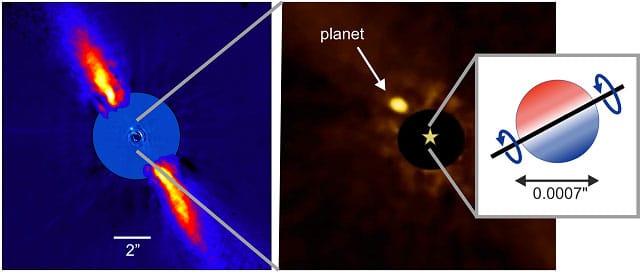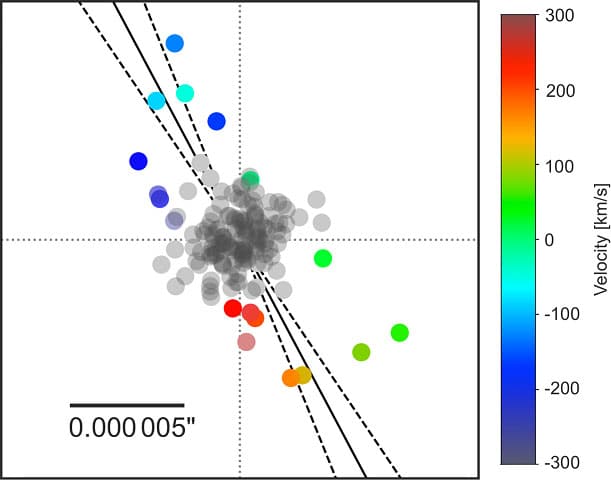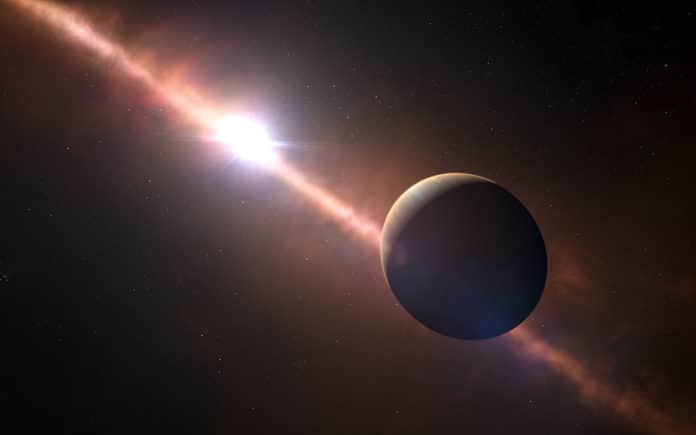For the first time, astronomers have measured the spin-orbit alignment for a distant ‘super-Jupiter’ planet called Beta Pictoris b that located 63 light-years from Earth. The planet, found in the Pictor constellation, has a mass of around 11 times that of Jupiter. It orbits a young star on a similar orbit as Saturn in our solar system.
Astronomers have demonstrated a method that could empower breakthroughs in the quest to see how exoplanetary systems form and evolved. The technique measures the tiny spatial displacement of less than a billionth of a degree that is caused by Beta Pictoris’ rotation.
The measurements were led by Professor Stefan Kraus from the University of Exeter.
Professor Stefan Kraus said: “The degree to that a star and a planetary orbit are aligned with each other tells us a lot about how a planet formed and whether multiple planets in the system interacted dynamically after their formation.”

“It was a major surprise when it was found that more than a third of all close-in exoplanets orbit their host star on orbits that are misaligned concerning the stellar equator.”
“A few exoplanets were even found to orbit in the opposite direction than the rotation direction of the star. These observations challenge the perception of planet formation as a neat and well-ordered process taking place in a geometrically thin and co-planar disc.”
For the study, scientists used the GRAVITY instrument at the VLTI to carry out the measurements. They found that the stellar rotation axis is lined up with the orbital axes of the planet Beta Pictoris b and its extended debris disc.
Dr. Jean-Baptiste LeBouquin, an astronomer at the University of Grenoble in France and a member of the team, said, “Gas absorption in the stellar atmosphere causes a tiny spatial displacement in spectral lines that can be used to determine the orientation of the stellar rotation axis.”

“The challenge is that this spatial displacement is minimal: about 1/100th of the apparent diameter of the star, or the equivalent to the size of a human footstep on the moon as seen from Earth.”
The outcomes uncovered that the Beta Pictoris system is well-aligned as our solar system. This discovery favors planet-planet scattering as the cause for the orbit obliquities that are observed in more exotic systems with Hot Jupiters.
Be that as it may, observations on a large sample of planetary systems will be required to respond to this question conclusively. The group proposes another interferometric instrument that will permit them to acquire these estimations on many planetary systems that are about to be discovered.
Prof. Kraus said, “A dedicated high-spectral resolution instrument at VLTI could measure the spin-orbit alignment for hundreds of planets, including those on long-period orbits. This will help us to answer the question of what dynamical processes shape the architecture of planetary systems.”
Journal Reference:
- Stefan Kraus et al., Spin-Orbit Alignment of the β Pictoris Planetary System, The Astrophysical Journal (2020). DOI: 10.3847/2041-8213/ab9d27
